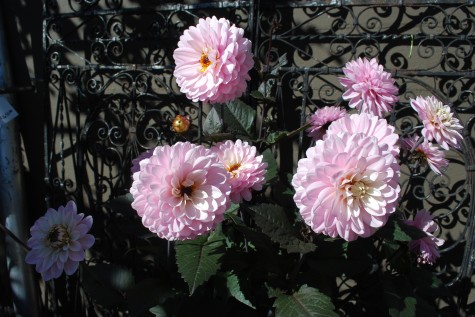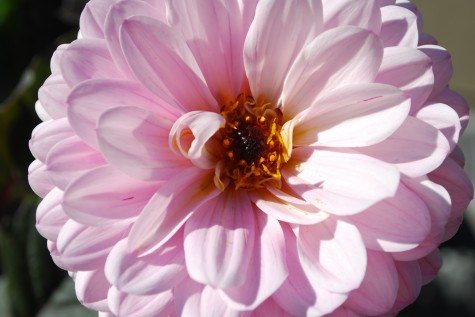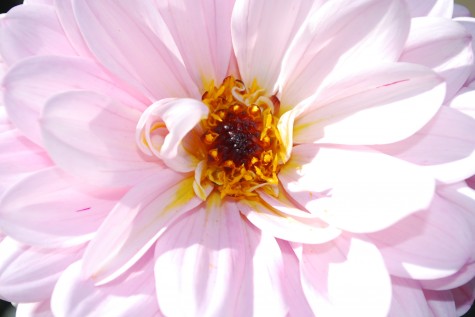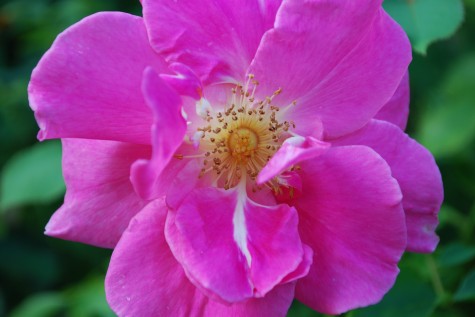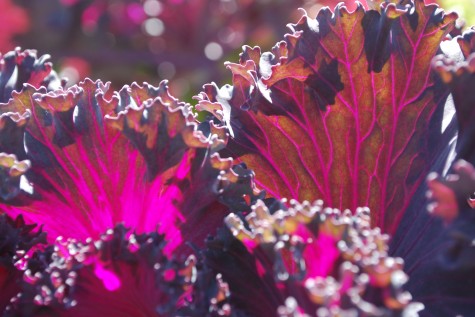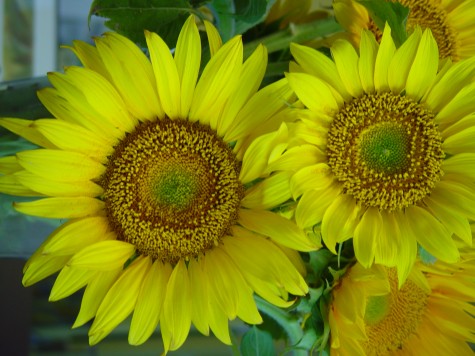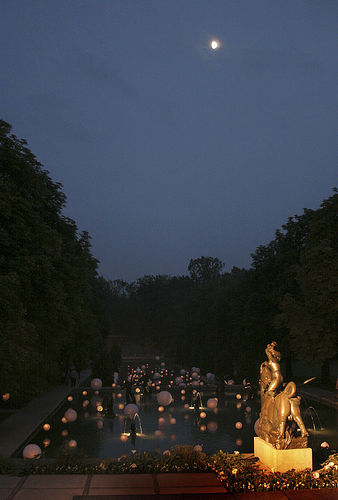
My post yesterday dealt with the process of design and installation of the decor for a fundraiser to benefit the Art Academy at Cranbrook. With the donation of my time and effort came an invitation to attend the event. As I do not always get the chance to see how what I have planned works or doesn’t work, I looked forward to being a guest. Much of the success of any party in a garden relies upon its thoughtful lighting. An event with the word moonlight in its title made the notion of lighting the night the centerpiece of our design. Our first bit of timely cooperation from nature-as dusk approached, the rainy skies cleared to reveal the full moon. Be advised the date of the full moon this July had been researched by the committee, and the date for the event was set accordingly.
 The benefactor tables surrounding the upper level Orpheus fountain glowed with the soft light from hundreds of votive candles set on their surfaces. The white tablecloths, umbrellas, garden flowers,the costumes of the dance troup and water reflected light in every direction. This kind of romance makes people feel good.
The benefactor tables surrounding the upper level Orpheus fountain glowed with the soft light from hundreds of votive candles set on their surfaces. The white tablecloths, umbrellas, garden flowers,the costumes of the dance troup and water reflected light in every direction. This kind of romance makes people feel good.
 The votive-lit lanterns skimming the surface of the Triton pools were repeated ingound, lighting the path from the entrance to the event, to its center. Designing and creating a walk to the event gave every guest the chance to shift their visual gears from their every day landscape to this specially made and momentary landscape. This transition helps to build anticipation for the event; when I have the idea I am going to enjoy something, I usually do.
The votive-lit lanterns skimming the surface of the Triton pools were repeated ingound, lighting the path from the entrance to the event, to its center. Designing and creating a walk to the event gave every guest the chance to shift their visual gears from their every day landscape to this specially made and momentary landscape. This transition helps to build anticipation for the event; when I have the idea I am going to enjoy something, I usually do.

The relationship of still water, spouting water,and glowing spheres took on an entirely different and dramatic aspect after dusk. I did not expect to see so many guests photographing what they saw on cell phones, but I was very pleased none the less. The majority of these photographs, taken by Jason Ruff, are a considerable addition to my memory of the garden that night.
 I had not thought about the fact that the level of glow the one votive candle tucked into each sphere would vary greatly given the size of that sphere. That variation in light level proved especially beautiful – courtesy of a little physics via the umbrella we call nature.
I had not thought about the fact that the level of glow the one votive candle tucked into each sphere would vary greatly given the size of that sphere. That variation in light level proved especially beautiful – courtesy of a little physics via the umbrella we call nature.
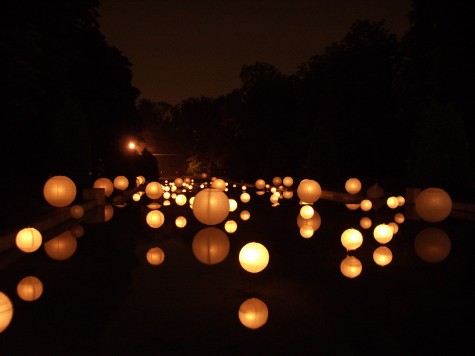 As the evening wore on, the intensity of light emitted from the spheres, and the diminishing ability to gauge the water level gave the impression that all the spheres were floating on, or hovering over the water.
As the evening wore on, the intensity of light emitted from the spheres, and the diminishing ability to gauge the water level gave the impression that all the spheres were floating on, or hovering over the water.
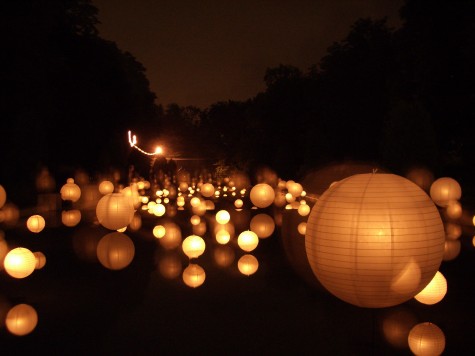 The reflection of the spheres in the still water made it seem like the spheres were multiplying. The water, the weather, and the light acting on those spheres made this event. How weather acts on a landscape is a critical factor in its success. I do my best work when I am paying attention to that.
The reflection of the spheres in the still water made it seem like the spheres were multiplying. The water, the weather, and the light acting on those spheres made this event. How weather acts on a landscape is a critical factor in its success. I do my best work when I am paying attention to that.
 Of course there would be music, dining and dancing. The bidding on the art at auction was brisk; people were enjoying themselves. It was such a pleasure seeing the Triton pools, and their sculptures at night.
Of course there would be music, dining and dancing. The bidding on the art at auction was brisk; people were enjoying themselves. It was such a pleasure seeing the Triton pools, and their sculptures at night.
 The perfect moment that night? The coming of the frogs. Late in the evening, the spheres were host to many hundreds, maybe thousands, of frogs. They gravitated to the spheres, and took up residence. Everyone could hear them singing, before anyone spotted where they were perched. Some said the rhythm of that singing matched the rhythm of the music; I choose to believe that was so.
The perfect moment that night? The coming of the frogs. Late in the evening, the spheres were host to many hundreds, maybe thousands, of frogs. They gravitated to the spheres, and took up residence. Everyone could hear them singing, before anyone spotted where they were perched. Some said the rhythm of that singing matched the rhythm of the music; I choose to believe that was so.
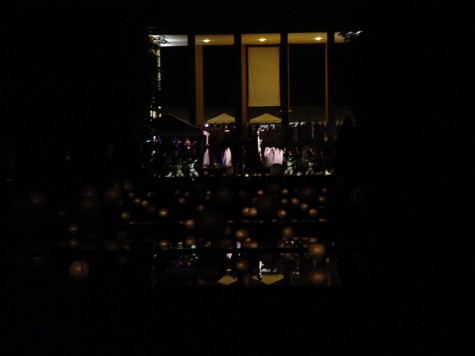
I learned plenty about my place in the big scheme of things that night. No one could have invited the frogs, but that they came is what made that night unforgettable.
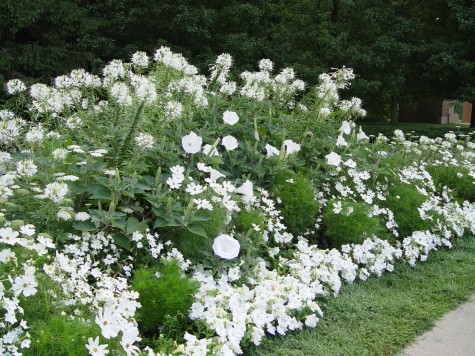
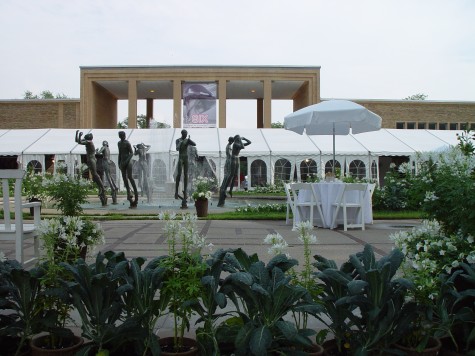 A large tent would be a temporary home to a collection of art destined for auction that evening. Each work was donated by a previous graduate of the academy; this part of the event generated considerable interest and participation. Tables reserved for groups representing the major benefactors for this event were placed in the fountain garden.
A large tent would be a temporary home to a collection of art destined for auction that evening. Each work was donated by a previous graduate of the academy; this part of the event generated considerable interest and participation. Tables reserved for groups representing the major benefactors for this event were placed in the fountain garden.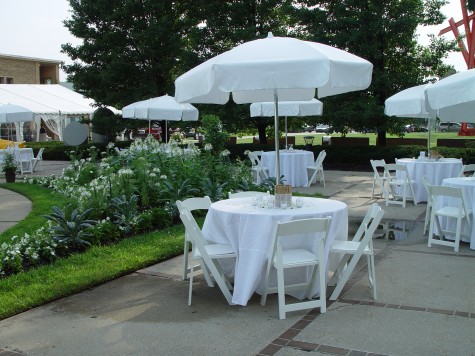 The remnants of puddles you see on the ground in the above picture bring back memories for me; it rained fiercely the afternoon of the event. What I had thought I would have the entire day to accomplish would have to be done in less time. The threat of bad weather makes any garden party all the more exciting to plan and produce-in this case, it was more excitement than I really wanted.
The remnants of puddles you see on the ground in the above picture bring back memories for me; it rained fiercely the afternoon of the event. What I had thought I would have the entire day to accomplish would have to be done in less time. The threat of bad weather makes any garden party all the more exciting to plan and produce-in this case, it was more excitement than I really wanted. 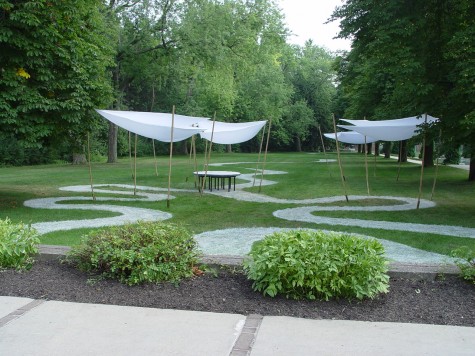 A cocktail reception would be held in a grassy area immediately adjacent to the showpiece of the Cranbrook landscape-the Triton pools. We fashioned simple tents for the hordoerves tables from double layers of white fabric attached to bamboo poles. Steel shoes for the poles were sunk in the ground at an outward angle, stretching the fabric tight and smooth. Nature had another idea in store; the intense downpour changed that flat profile to a graceful swoop. This unexpected contribution from the sky was a good one; I liked the swooping fabric against the curving path. We had painted a rambling path for guests arriving at the Lone Pine entrance to the garden to the reception area, with athletic paint.
A cocktail reception would be held in a grassy area immediately adjacent to the showpiece of the Cranbrook landscape-the Triton pools. We fashioned simple tents for the hordoerves tables from double layers of white fabric attached to bamboo poles. Steel shoes for the poles were sunk in the ground at an outward angle, stretching the fabric tight and smooth. Nature had another idea in store; the intense downpour changed that flat profile to a graceful swoop. This unexpected contribution from the sky was a good one; I liked the swooping fabric against the curving path. We had painted a rambling path for guests arriving at the Lone Pine entrance to the garden to the reception area, with athletic paint. 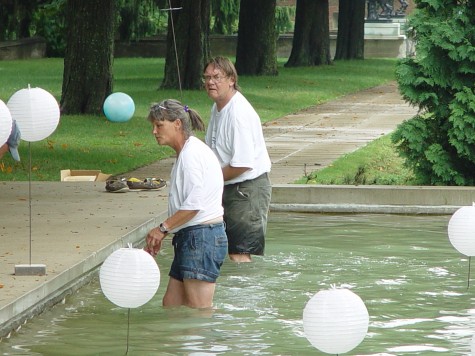 The big gesture? I had the idea to affix paper lanterns to slender steel rods anchored with bricks which would sit on the on the pool bottom. Advance measurements of the water depth enabled us to create the impression that the lanterns were floating on the surface of the water. What fun it was to get in these fountains; I never expected this opportunity to come along. A crew of four of us spent the better part of the afternoon wading in the water.
The big gesture? I had the idea to affix paper lanterns to slender steel rods anchored with bricks which would sit on the on the pool bottom. Advance measurements of the water depth enabled us to create the impression that the lanterns were floating on the surface of the water. What fun it was to get in these fountains; I never expected this opportunity to come along. A crew of four of us spent the better part of the afternoon wading in the water.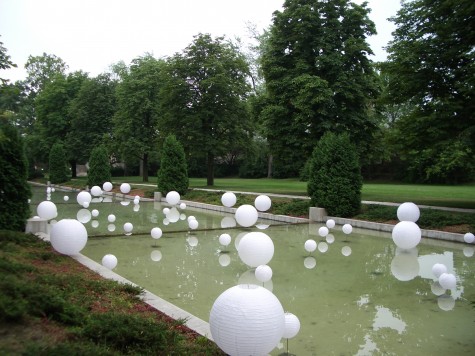 We set up hundred of lanterns of different diameters. Each steel rod had a platform at the top holding a votive candle. As we set the lanterns, we lit the votives rated to burn for ten hours, and hoped no more rain or wind would come our way. I was equally concerned that no water from the pools wick its way onto the paper. I was interested in creating a little moonlight magic, not a wet paper mess.
We set up hundred of lanterns of different diameters. Each steel rod had a platform at the top holding a votive candle. As we set the lanterns, we lit the votives rated to burn for ten hours, and hoped no more rain or wind would come our way. I was equally concerned that no water from the pools wick its way onto the paper. I was interested in creating a little moonlight magic, not a wet paper mess. It seemed the rain had cleared off, and we did finish with an hour to spare before guests were due to arrive. The reception would begin at the very far end of the pools, and guests would wind their way uphill.
It seemed the rain had cleared off, and we did finish with an hour to spare before guests were due to arrive. The reception would begin at the very far end of the pools, and guests would wind their way uphill. 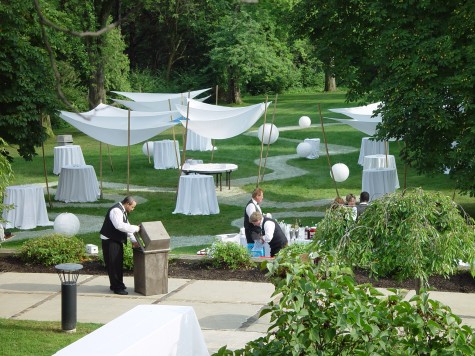 I was happy to have finished my part as the catering staff was setting up. I was on my way home to get dressed; I did not want to miss how all of this would look at night.
I was happy to have finished my part as the catering staff was setting up. I was on my way home to get dressed; I did not want to miss how all of this would look at night.  Attending an event gives you the chance to experience it as other people do. There is plenty to be learned from this-what proves awkward, what is not visually strong enough when a space is full of people, what proves to be good that you never gave a moment’s thought to. Any party in a garden will surprise you.
Attending an event gives you the chance to experience it as other people do. There is plenty to be learned from this-what proves awkward, what is not visually strong enough when a space is full of people, what proves to be good that you never gave a moment’s thought to. Any party in a garden will surprise you.
